The Jewish War on White Australia: Colin Tatz and the Genocide Charge—PART THREE
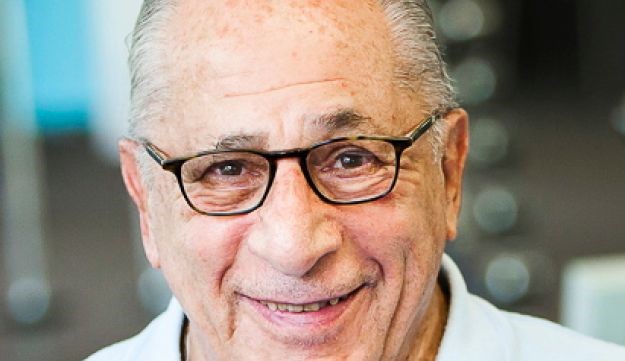
Professor Colin Tatz
Critiquing Australia
From his arrival in Australia in 1961, Colin Tatz quickly identified those aspects of Australian society to his extreme distaste—what he describes as the “warts, some of which I have watched grow into malignant lumps.”[1] Foremost among these, he claims, was the gap in social indicators between White Australians and the Aborigines. Australia’s indigenous population has always had the worst health, and the lowest educational, occupational, economic, and social status of any identifiable section of the Australian population. The annual report on progress in the Australian government’s strategy of “Closing the Gap” between indigenous and non-indigenous Australians has been called an “annual statement of failure, a catalogue of defeat.”
In 2015–16, $33.4 billion of Australian taxpayers’ money was spent on Aboriginal programs: $44,886 for every Aborigine in the nation. More than a thousand government initiatives seek to ameliorate the myriad manifestations of Aboriginal social and economic dysfunction. In many communities there is one service for every five residents. Wilcannia, in New South Wales, for example, had 102 funded services in 2012 for an indigenous population of 474. Despite this, Aboriginal people continue to trail other Australians in virtually all metrics including life expectancy, child mortality, health, education and employment. As journalist Grace Collier noted: “The problems are shocking but seem intractable—we feel horrified and helpless; we don’t know how to assist. Worse, no matter how much money we give, it is never enough. Thirty-three billion dollars a year goes off into the ether, never to be seen again, and nothing seems to ever improve.”
Despite the burgeoning funding of proliferating Aboriginal programs, the Aboriginal leader and activist June Oscar had the nerve to excoriate successive governments for “abandoning” their commitment to tackling Aboriginal disadvantage, and for failing to execute and adequately fund Closing the Gap. Rather than responsibility for the lack of any improvement residing with Aboriginal people themselves, Oscar maintained that failure of achieve the Closing the Gap targets measured nothing but “the collective failure of Australian governments to work together and stay the course.”
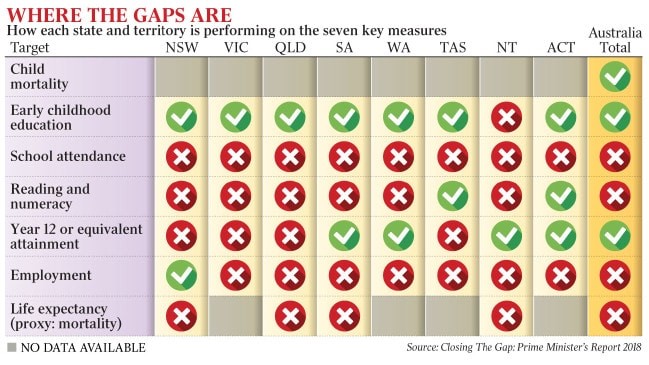
Closing the Gap Data: The Gap in School Attendance is Clearly the Result of White Racism
Colin Tatz is dismissive of government efforts to close the gulf between Aborigines and non-Aborigines, arguing this approach “reduces Aboriginal Australians to a range of indicators of deficit, to be monitored and rectified towards government-set standards.”[2] In his view, the Closing the Gap strategy is more about “achieving government desires to alter statistics that look bad for us, a First World prosperous country.”[3] Tatz attributes the dysfunction in Aboriginal communities not to Aborigines themselves, but to the poor treatment he claims they receive at the hands of White Australian bureaucrats, whose efforts to relieve Aboriginal distress are merely designed “to make the ‘rescuers’ look better, more like decent and democratic colonisers.”[4]
This attempt to blame the intractable social pathologies of Australia’s Aborigines on the evil legacy of European colonialism, “genocide” and “racism” is the purest anti-White propaganda. The traditional hunter-gatherer lifestyle of the Australia’s Aborigines was severely disrupted by the arrival of Europeans. There were around 300,000 Aborigines in Australia at the time of European colonization in 1788. Their numbers declined considerably in the decades that followed, mainly due to diseases contracted from Europeans for which they had no immunity. Aborigines were also killed by Whites in violent clashes on the frontier—often in reprisal for attacks on Whites. Violence against Aborigines was specifically prohibited by the governing authorities, and White settlers were charged with murder and executed for killing Aborigines. The 1961 census reported that the Aboriginal population of Australia at around 106,000. This had increased to 171,000 by 1981, and, incredibly, to over 800,000 in the 2016 census, suggesting the $33 billion in Closing the Gap programs is fueling a population boom. This figure has been inflated by those with tiny amounts of Aboriginal ancestry (or none) now claiming to be Aboriginal to take advantage of the ever-multiplying indigenous welfare programs, scholarships and career opportunities.
Denial of low Aboriginal IQ
Notwithstanding the fact European colonization had a range of negative effects on Australia’s Aborigines, the real (though never acknowledged) source of their dysfunctional communities is their extraordinarily low average intelligence. According to psychologist Richard Lynn, the first attempt to estimate the intelligence of the Australian Aborigines was made by Francis Galton in 1869. From descriptions of their accomplishments, he estimated that their intelligence was approximately three “grades” below that of the English. Lynn explains that: “In Galton’s metric, a grade was equivalent to 10.4 IQ points. Hence in terms of the IQ scale, he estimated the Australian Aborigine IQ at 68.8. Seventeen studies of the intelligence of Australian Aborigines assessed by intelligence tests have shown that this was a fairly accurate assessment. … The median IQ of the seventeen studies is 62 and represents the best estimate of the average intelligence of Australia’s Aborigines”[5]
The findings from studies into Aboriginal IQ have been corroborated by a study showing Aborigines have slower reaction times (reaction time being moderately correlated with IQ). Four studies of the average IQ of Aboriginal-European hybrids put it at 78—midway between the IQs of Aborigines and Europeans. The low average intelligence of Aborigines is supported by their very low levels of educational attainment. Lynn notes that: “Aborigines do poorly in education, consistently with their low intelligence, showing that their low cognitive abilities are not confined to their performance on intelligence tests.”[6] A recent report from the Grattan Institute found that remote indigenous children are five years behind the typical student in numeracy, six years behind in reading, and seven to eight years behind in writing by the time they are in Year 9 [aged 15]. “In other words,” according to the study author Peter Goss, “the average Year 9 indigenous student in a very remote area scores worse on the NAPLAN writing test than the average Year 3 [aged 8] non-indigenous student.” The reality is that a population with a mean IQ of 62 (or even 78 for mixed race Aborigines) is incapable of functioning effectively in a modern technological society like Australia.
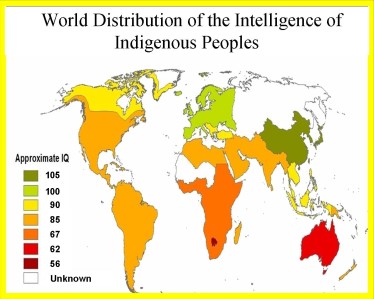
Tatz exposes himself as an intellectual charlatan in his comprehensive rejection of the accumulated evidence demonstrating racial differences in average intelligence. In his determination to subordinate the truth to his ethnic agenda, Tatz, who purports to be “meticulous about matters of fact,” dismisses the accumulated psychometric evidence by deploying the epithet “scientistic racism.” His rhetorical technique is not to cite contradictory evidence (for there is none), but to catalogue the supposedly wrongheaded and malevolent claims about race that, he insists, Western scientists have historically used to justify the oppression of non-Whites:
Appreciating the race factor also requires going through the growth of “scientistic racism,” that is, the works of anatomists and physical anthropologists who began to examine and compare the human form and then started to attribute social characteristics to the physical ones. When physical forms as such could not establish a “suitable” hierarchy of races, they turned to measurements of “intelligence,” using craniology (skull measurement) as the ultimate criterion. Researchers concluded that Caucasians—named after what was thought to be the perfect (“white”) skull found in the Caucasus mountains in Russia—had the largest brain casing (87 cubic inches), according to physician Samuel Morton in his Crania Americana (1839). Native Americans had a mean volume of 82 cubic inches (measured using mustard seed) that, Morton deduced, made them slow of thought, averse to agriculture, vengeful, and lovers of warfare. Ethiopian and black skulls held an even smaller quantity of seed (78 cubic inches) but their owners’ bodies were the more muscular. Thus, laboratories spawned the brain versus brawn (or white versus black) dichotomy that is still prevalent in many circles. Australia’s Indigenous people (“Australoids”) had less skull volume than any other people, and were ascribed as having even more reduced capacities—a furphy propagated in Australian school texts until the 1980s.[7]
Tatz cites no actual evidence to contradict this “furphy,” and conveniently ignores more recent and precise measures of skull volume including seven studies showing the average brain size of Aborigines is significantly smaller that Europeans (brain size being correlated with IQ at approximately 0.4). The most authoritative study of Aboriginal brain size is that of Smith and Beals (1990) which gave a brain size difference of 144cc. or about 10 per cent. Tatz also completely rejects the validity of IQ testing, including the Stanford-Binet intelligence test which he claims is “still in use, or misuse, today for streaming children into different levels of education, for separating classes of people, the bright from the simple, and so on.” He contends that, “No matter what spin one puts on modern IQ testing, it remains of the same genre and ‘scientific’ validity as skull measuring.”[8] For Tatz, IQ tests were developed as part of the conspiracy by White supremacists in the U.S. to create a society that was White and Protestant and excluded Jews and Blacks.[9]
Such sophistry emanates from a man extolled by a colleague for his “fierce fidelity to truth,” a trait that has “won him a well-deserved international reputation as an intellectual,” and has “attracted the toxic enmity of those who have a vested interest in untruth.”[10] Tatz aptly characterizes his own egregious denial of racial differences in intelligence in noting that “individuals and collectives usually know (or can reasonably infer) a great deal more than they’re prepared to acknowledge. Denialist discourses present accounts of circumstances in question that obliterate or falsify their actual character. … The common technique is quintessentially assertion and contention rather than any attempt at demonstration or affirmation of their viewpoints.[11] He shares this trait with fellow Jewish academic and “Stolen Generations” propagandist, Robert Manne, who, as historian Bain Attwood has pointed out, “asserts rather than argues.”[12]
Dismissing over a century of psychometric evidence showing a gulf in mean IQ between White Australians and Aborigines allows Tatz to ascribe the dismal state of Aboriginal communities exclusively to White malevolence. He even makes the laughable claim that, prior to the 1960s, “Aborigines were, in general, the most law-abiding sector of the Australian population,” whereas now they would have to be “considered, statistically, to be the most criminal population on the planet.”[13] Indeed, he claims, “as more education, training and intervention programs are established, so more and more youth are imprisoned. Some 28 percent of all prisoners in custody are Aboriginal, a figure that brands them as the world’s foremost criminals.”[14] The link between low intelligence and a greater propensity for violent crime has been well established by criminological research.
A study recently published in the British Medical Journal by Australian researchers found, in a study of about 100 young people aged 10–17 incarcerated in Western Australia (which has a very high Aboriginal prison population), 89 per cent had at least one area of severe neurodevelopmental impairment, such as problems with memory, cognition or motors skills. The study found about a quarter were found to have to have an intellectual disability, with an IQ score at or below 70. The director of the study, Carol Bower, noted that “Almost half the young people had severe problems with language, how to listen and reply and explain what they think.”
Denial of the anthropological record
In his risible claim that Aborigines were once “the most law-abiding sector of the Australian population,” Tatz disregards anthropological evidence showing Aboriginal societies were, prior to contact with Europeans, extremely abusive to women and children and generally violent. In 1995 paleopathologist Stephen Webb published his analysis of 4500 individuals’ bones from mainland Australia going back 50,000 years. These bone collections were at the time being handed over to Aboriginal communities for re-burial, which stopped any follow-up studies.
He found highly disproportionate rates of injuries and fractures to women’s skulls, with the injuries suggesting deliberate attack and often attacks from behind, perhaps from domestic squabbles. In the tropics, for example, female head injury frequency was about 20–33%, versus 6.5–26% for males. The most extreme results were on the south coast, from Swanport and Adelaide, with female cranial trauma rates as high as 40–44%—two to four times the rate of male cranial trauma. In desert and south coast areas, 5–6% of female skulls had three separate head injuries, and 11–12% had two injuries.
The high rate of injuries to female heads was very different from the results from studies of other peoples. His findings, according to anthropologist Peter Sutton, confirm that serious armed assaults were common in Australia over thousands of years prior to the arrival of Europeans.
From British settlement in 1788, Europeans arriving in Australia were shocked at the extreme physical violence Aboriginal men inflicted on their women. Watkin Tench, a British marine officer who arrived on the First Fleet, noticed a young woman’s head “covered by contusions, and mangled by scars.” She had a spear wound above her left knee caused by a man who dragged her home to rape her. Tench wrote: “They are in all respects treated with savage barbarity; condemned not only to carry the children, but all other burthens. They meet in return for submission only with blows, kicks and every other mark of brutality.”[15] Tench observed that when an Aboriginal man “is provoked by a woman, he either spears her, or knocks her down on the spot; on this occasion he always strikes on the head, using indiscriminately a hatchet, a club, or any other weapon, which may chance to be in his hand.” British soldier William Collins recounted how “We have seen some of these unfortunate beings with more scars upon their shorn heads, cut in every direction, than could be well distinguished or counted.”[16]
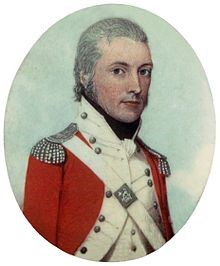
Watkin Tench
In 1802 an explorer in the Blue Mountains in New South Wales wrote how, for a trivial reason, an Aboriginal “took his club and struck his wife’s head such a blow that she fell to the ground unconscious. After dinner … he got infuriated and again struck his wife on the head with his club, and left her on the ground nearly dying.”[17] In 1825, the French explorer Louis-Antoine de Bougainville observed that “that young girls are brutally kidnapped from their families, violently dragged to isolated spots and are ravished after being subjected to a good deal of cruelty.”[18]
George Robinson observed in the 1830s that Aboriginal men in Tasmania “courted” their women by stabbing them with sharp sticks and cutting them with knives prior to rape.[19] A contemporaneous account by an ex-convict named Lingard noted that: “I scarcely ever saw a married woman, but she had got six or seven cuts in her head, given by her husband with a tomahawk, several inches in length and very deep.”[20] Explorer Edward John Eyre similarly observed that “women are often sadly ill-treated by their husbands and friends. … They are frequently beaten about the head, with waddies [clubs], in the most dreadful manner, or speared in the limbs for the most trivial offences. … Few women will be found, upon examination, to be free from frightful scars upon their head, or the marks of spear wounds about the body. I have seen a young woman, who, from the number of these marks, appeared to have been riddled with spear wounds.”[21]
Tribal warfare and paybacks were endemic among Aborigines. The anthropologist T.G.H. Strehlow witnessed a battle in 1875 in Central Australia which was triggered by a perceived sacrilege: “The warriors turned their murderous attention to the women and older children and either clubbed or speared them to death. Finally, according to the grim custom of warriors and avengers they broke the limbs of the infants, leaving them to die ‘natural deaths.’” The final number of the dead could well have reached the high figure of 80 to 100 men, women and children. Subsequent revenge killings by the victims’ clan amounted to more than 60 people.[22]

William Buckley
Escaped convict William Buckley, who lived for over three decades with an Aboriginal tribe around Port Phillip Bay in present-day Victoria in the early nineteenth century, witnessed constant raids, ambushes and massacres. Buckley noted how the Watouronga tribe of Geelong in night raids “destroyed without mercy men, women and children.”
Buckley also described the practice of cannibalism between the warring tribes of the area, including the practice of eating flesh from the legs of slain warriors which “was greedily devoured by these savages.” He mentions their practice of mortuary cannibalism for love, relating that “they eat also the flesh of their own children to whom they have been much attached should they die a natural death,” and described how:
They have a brutal aversion to children who happen to be deformed at their birth. I saw the brains of one dashed out at a blow, and a boy belonging to the same woman made to eat the mangled remains. The act of cannibalism was accounted for in this way. The woman at particular seasons of the moon, was out of her senses; the moon—as they thought—having affected the child also; and certainly it had a very singular appearance. This caused the husband to deny his being the father, and the reason given for making the boy eat the child was, that some evil would befall him of he had not done so.[23]
Tatz ignores Buckley’s detailed eyewitness account of Aboriginal cannibalism, falsely claiming that “we do not have a single eyewitness account of Aboriginal cannibalism.” When the Australian politician Pauline Hanson referred to the Aboriginal practice of cannibalism in 1997, an incensed Tatz equated it with “the blood libel against the Jews,” claiming “the Hanson vilification about cannibalism is not of the same magnitude or consequence, but it is very much in the same genre.”[24]
The anthropological record totally undermines Tatz’s preferred narrative that the current epidemic of violence in Aboriginal communities is an historical aberration that can be attributed to their “genocide” and victimization at the hands of Whites. The above referenced Stephanie Jarrett notes that violence and abuse against women and children in Aboriginal communities are currently at “catastrophic levels” and that “It is important to acknowledge [the] link between today’s Aboriginal violence and violent, pre-contact tradition, because until policymakers are honest in their assessment of the causes, Aboriginal people can never be liberated from violence. … Deep cultural change is necessary, away from traditional norms and practices of violence.”[25] Aboriginal woman Bess Price, in her forward to Jarrett’s book pointed out that “my own body is scarred by domestic violence” and noted that “Aboriginal people have to acknowledge the truth. We can’t blame all of our problems on the white man.”[26]
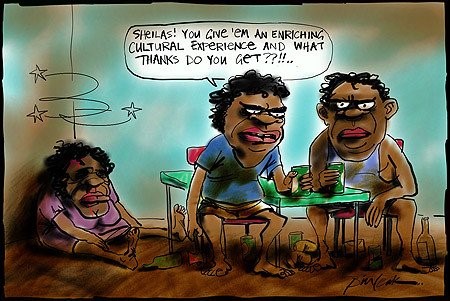
The late political cartoonist Bill Leak drops a truth bomb
Given the anthropological record, it is hardly surprising that today’s Aborigines are ten times more likely to commit homicide than Europeans and are ten to fifteen times more likely to commit a serious assault. The latest statistics from the Australian Institute of Health and Welfare show that Aboriginal women are 32 times more likely than non-Aboriginal women to be hospitalized because of family violence. Similarly, Aboriginal men are 23 times more likely to be hospitalized. Two in five homicide victims (41 percent) were killed by a current or former partner, compared with one in five homicide victims. Aboriginal communities suffer Australia’s worst rates of family violence, which are causing Aboriginal women to be hospitalized at 35 times the rate of non-Aboriginal women. Aborigines are, consequently, vastly overrepresented in Australia’s prison population.
It is common to blame White Australia for this astounding level of incarceration. Richard Lynn cites an Australian sociologist who argues that “the key general cause of the perceived criminalisation of Aborigines is universally perceived to be socioeconomic deprivation and consequential exclusion” and that “the underlying issues of unemployment, poverty, ill-health, dispossession, and disenfranchisement are the causes of the over-involvement of Aborigines in prison” and that these are themselves “the product of indirect discrimination.” Lynn notes wryly that: “Thus it is the Europeans who are responsible for the high crime rates of the Aborigines.”[27]
[1] Colin Tatz, Human Rights and Human Wrongs: A Life Confronting Racism (Clayton, Victoria; Monash University Publishing, 2015), 347.
[2] Colin Tatz, Australia’s Unthinkable Genocide (Xlibris; 2017), 1772.
[3] Ibid., 3169.
[4] Tatz, Human Rights and Human Wrongs, 355.
[5] Richard Lynn, The Global Bell Curve (Washington Summit, 2010), 47-8.
[6] Ibid., 48.
[7] Colin Tatz, “Teaching About Genocide,” In: Genocide Perspectives: A Global Crime, Australian Voices, Ed. Nikki Marczak & Kirril Shields (Sydney: UTS ePress, 2017), 241-2.
[8] Ibid., 242.
[9] Tatz, Australia’s Unthinkable Genocide, 892.
[10] Douglas Booth, “Colin Tatz: ‘Compelled to Repair a Flawed World,’” In: Genocide Perspectives: A Global Crime, Australian Voices, Ed. Nikki Marczak & Kirril Shields (Sydney: UTS ePress, 2017), 16.
[11] Tatz, Australia’s Unthinkable Genocide, 2146.
[12] Bain Attwood, The Stolen Generations and Genocide, 166.
[13] Tatz, Australia’s Unthinkable Genocide, 1343.
[14] Tatz, Human Rights and Human Wrongs, 355.
[15] Nowra, Bad Dreaming: Aboriginal Men’s Violence Against Women & Children (Melbourne: Pluto Press, 2007), 10.
[16] Peter Sutton, The Politics of Suffering: Indigenous Australia and the End of the Liberal Consensus (Melbourne: University of Melbourne Press, 2009), 100.
[17] Nowra, Bad Dreaming, 13.
[18] Joan Kimm, A Fatal Conjunction: Two Laws Two Cultures (Sydney: Federation Press, 2004), 76.
[19] Nowra, Bad Dreaming, 12.
[20] Ibid., 12.
[21] Stephanie Jarrett, Liberating Aboriginal People from Violence (Victoria: Ballan, 2013), 123.
[22] website
[23] William Buckley, The Life and Adventures of William Buckley: Thirty-Two Years a Wanderer Amongst the Aborigines of the Then Unexplored Country Round Port Phillip, Now the Province of Victoria (Hobart: Archibald MacDougall, 1852), 66-7.
[24] Raphael Israeli, The Blood Libel and Its Derivatives: The Scourge of Anti-Semitism (London: Routledge, 2017), 4.
[25] Jarrett, Liberating Aboriginal People from Violence, 1.
[26] Ibid., 291.
[27] Ibid. p. 56





Comments are closed.